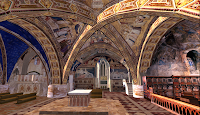The Franciscan Liturgical Art - An Inspiration for Rebuilding the Church Today
 The rich artistic fruit of the spirituality of charity and poverty. Following the excellent feature introduced by Shawn Tribe - the Sacred Liturgy and the Apostolate - on how liturgy is the 'indespensable' source of momentum for increased charity and social and cultural regeneration; and my own piece Should We Sell All the Art in the Vatican and Give the Money to the Poor?, I thought that I would explore a little further the part that sacred art and the beautiful decoration of our churches has to play in this. St Francis of Assisi is the figure to whom are encouraged to look in this regard, so perhaps the easiest way to think about this is to consider the effect he had in his day.
The rich artistic fruit of the spirituality of charity and poverty. Following the excellent feature introduced by Shawn Tribe - the Sacred Liturgy and the Apostolate - on how liturgy is the 'indespensable' source of momentum for increased charity and social and cultural regeneration; and my own piece Should We Sell All the Art in the Vatican and Give the Money to the Poor?, I thought that I would explore a little further the part that sacred art and the beautiful decoration of our churches has to play in this. St Francis of Assisi is the figure to whom are encouraged to look in this regard, so perhaps the easiest way to think about this is to consider the effect he had in his day.
I am no expert on St Francis himself so I am taking a simple approach. I am working on a couple of assumptions that I am hoping are reasonable: that a focus on charity and concern for poor and the art of third order Franciscans artists are all reflective of the Franciscan spirit of the age; and these are consistent with the spirituality of St Francis himself. The artists are those such as Giotto, Cimabue and the anonymous artist known as the 'Master of St Francis'.
There are a number of points that can be made about the art. Just looking at the interiors of these churches one can say that there is huge importance attached to their beauty and harmony with the liturgy. But it goes further than that. They are highly innovative. Features such as the increased naturalism and heightened sense of the suffering of Christ represented a departure from the strict iconographic prototype that governed the art of period before. However, although innovative the always worked within the broader the principles of what makes art worthy of veneration and it is therefore authentic sacred art that deepens our participation in the liturgy. There is no accounting for how God might choose to inspire individual artists, but it does not seem conceivable to me that a whole culture changing movement which is for the good, (which is what we are talking about here), could happen without a deep attachment to the liturgy.
If we look at the interiors of the churches, for example, notice how much is adorned with geometric patterned art. This suggests to me an deep awareness of the sources of the symbolism that generates such geometry, predominantly scripture and the cosmos. One of the commonly held ideas of Franciscan spirituality is that of an interest in and love of the beauty of the natural world that St Francis inspired. Whatever the truth of this, I would say that as a general principle one could not create such 'cosmic' art unless one was able to read the cosmos symbolically and had a deep understanding of how that symbolism and the beauty of the cosmos points us to something greater, to the rhythms of the heavenly liturgy and ultimately to God.
To the degree that all of this inspires a true liturgical devotion, then, as Shawn's feature points out, this will inspire devotion also to charity for the poor. In addition, one should say that he needs of the poor are spiritual as well as material. The poor need their souls saving just as much as the rich do and this art is for all people, rich and poor.
To my mind, all of this beauty is consistent with the twin aims that I have heard Pope Francis speak of rebuilding the Church - evangelisation - and caring for poor. When one relies on God we rest in an infinite and superabundant source of all that is good (including wealth). Inspiring people, rich and poor alike to come closer to God will create benefits in every area of our lives. Pictures are of the interior of the Basilica of St Francis:
I couldn't find this in high resolution, but I wanted to show it because of the traditional quincunx design on the altar (the shape where four circles spin out of the central circle - symbolising the creation of the cosmos),
Above: a crucifixion by Cimabue contrasted with an iconographic (Romanesque) cross painted in Umbria in the 12th century. The former focusses on the suffering of Christ, while the latter on his glory on the cross.
Below: St John and Our Lady during the Passion from the Master of St Francis.
And finally my own version of the Franciscan gothic figures painted for the chapel at Thomas More College.








